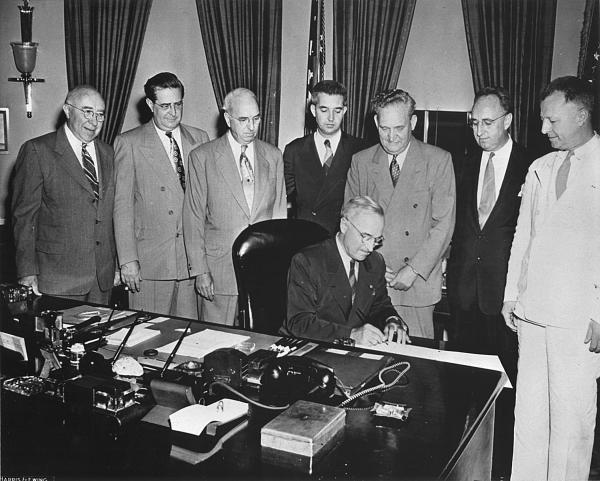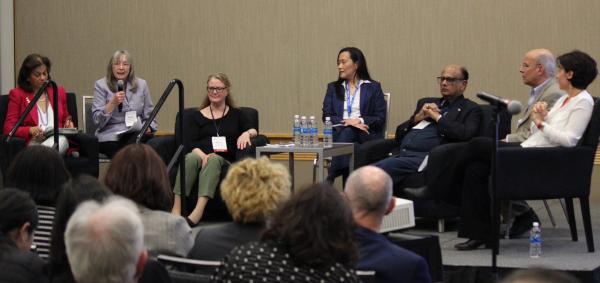NIDCR Celebrates 75 Years of “Scientific Strides”
BY MICHAEL SOMES, NIDCR
During the Second World War, rampant tooth decay disqualified nearly 20 percent of military recruits from service. To address this issue, President Truman signed legislation on June 24, 1948, to create what would eventually become the National Institute of Dental and Craniofacial Research (NIDCR). Today, NIDCR is celebrating its 75th anniversary by highlighting past accomplishments and presenting a vision for the future.
No fewer than three former NIDCR directors — Harold Slavkin, Lawrence Tabak, and Martha Somerman — as well as NIDCR’s current director, Rena D’Souza, took the stage to trumpet NIDCR history in March at the annual conference of the American Association for Dental, Oral, and Craniofacial Research in Portland, Oregon. This well-attended, two-hour symposium was titled “Scientific Strides of the NIDCR: 75 Years and Beyond.”
NIDCR Director Rena D'Souza speaks about the institute's accomplishments and charts a path for the future of dental, oral, and craniofacial health.

CREDIT: NIDCR
Slavkin, former NIDCR director, at a brainstorming session to create the NIDCR mission, which today reads: Our mission is to advance fundamental knowledge about dental, oral, and craniofacial (DOC) health and disease and translate these findings into prevention, early detection, and treatment strategies that improve overall health for all individuals and communities across the lifespan to promote oral health for all.
Slavkin, while director, invited groups of then-National Institute of Dental Research (NIDR) employees, about 10 at a time, to join him for discussions to promote greater collaboration. One topic of frequent discussion was how to better capture the breadth of NIDCR’s research portfolio. Ultimately, these efforts culminated in persuading Congress to add “Craniofacial” to NIDR’s name, leading to its present initials and reflecting the institute’s broadened research mission.
Tabak emphasized the key role collaboration across the institute played in moving NIDCR forward. He specifically highlighted the role NIDCR played in Medicaid’s policy to reimburse pediatricians for preventative care.
Somerman further expanded connections across disciplines and increased NIDCR’s clinical research efforts. Each set the stage for D’Souza, who has since built upon Somerman’s progress to address the “fuzzy middle” of preclinical research that occurs between basic science efforts and clinical trials. D’Souza emphasized the need to stay nimble and flexible, while always centering the patient. As with the other directors, her efforts to keep expanding NIDCR’s network of collaborators and new researchers is ongoing.
“Seventy-five years ago, Harry Truman was scratching his head” at the epidemic of dental decay affecting Americans, D’Souza reminded the audience. “He felt the need to create a national institute that would look at the biology of this condition. We stay true to that mission today.”

CREDIT: NIDCR
During the Second World War, rampant tooth decay disqualified nearly 20 percent of military recruits from service. To address this issue, President Truman signed legislation on June 24, 1948, to create what would eventually become the National Institute of Dental and Craniofacial Research (NIDCR).
Continued advancement
NIDCR’s intramural research advancements that have shaped dentistry and oral medicine were discussed and celebrated at the symposium. The research projects, ranging from molecular-level basic science studies to translational work and clinical treatments, were presented by six NIDCR intramural investigators.
- Marian Young, Deputy Scientific Director and Senior Investigator in the Molecular Biology of Bones and Teeth Section
- Pamela Robey, Senior Investigator in the Skeletal Biology Section
- John (“Jay”) Chiorini, Associate Scientific Director, Scientific Resources, and Chief of the Adeno-virus Associated Biology Section
- Niki Moutsopoulos Associate Scientific Director, Tenure Track/Assistant Clinical Investigator Faculty Development and Investigator in the Oral Immunity and Infection Section
- Ashok Kulkarni, Senior Investigator and Chief, Functional Genomics Section and Director of NIDCR Gene Transfer Core
- Janice Lee Clinical Director and Chief of the Craniofacial Anomalies and Regeneration Section
Young kicked off the section by presenting her work on how bones form. That knowledge might reveal ways to use tissue engineering and regenerative medicine to ameliorate specific musculoskeletal diseases. “You have to figure out how things work before you can figure out how to fix them,” Young said. (See sidebar to learn more about Young’s work.)

CREDIT: NIDCR
NIDCR Director D’Souza (left) moderates a panel of NIDCR intramural researchers (from left to right) Pamela Robey, Marian Young, Janice Lee, Ashok Kulkarni, John Chiorini and Niki Moutsopoulos.
Robey highlighted the role played by specialized bone-marrow fibroblastic cells in building and dismantling bone. Fibroblasts secrete proteins that help construct and maintain the structural framework of tissues. Robey is interested in the role these cells play in replacing and regrowing tissues that have been lost to disease or injury.
Much of Robey’s work involves developing animal models to study bone and cartilage defects and characterizing the various cell types that might function as tools for regenerating human tissue.
Gene therapy represents another area that has advanced during NIDCR’s 75 years of research. Chiorini is exploring ways to repair the salivary gland after being damaged by cancer-treatment radiation. Development of this therapy began almost 40 years ago. Over the past 20 years, NIDCR researchers have addressed critical steps in the process such as how to introduce new genes to the salivary gland, which genes to introduce, and which animal models are best to test the techniques.
The Gene Transfer Core at NIDCR has produced transgenic and knockout animal models for use in preclinical research across NIDCR’s extramural and intramural programs, Kulkarni added.
NIDCR’s research has stretched to the broader fields of microbiology and immunology, according to Moutsopoulos. She and colleagues aim to leverage their focus on rare diseases into a better understanding of the basic biology of human oral diseases, including common forms of periodontitis.
Lee highlighted two recent, pandemic-era clinical studies, which included the identification of SARS-CoV-2 in the oral cavity, and a treatment study for fibrous dysplasia, a rare disease in which bone is replaced with fibrous scar tissue. Lee also highlighted how NIDCR’s seven clinical investigators and the team of nurses, physicians, and support staff in the Clinical Center form a strong network and build successful collaborations.
Still much to do
D’Souza shared an ambitious vision for the next 25 years. She hopes NIDCR research will help to achieve the following:
- Make salivary screening a regular part of oral health
- Contribute to a 50% reduction in the prevalence of dental cavities
- Identify the connections between periodontal disease and systemic conditions
- Prevent head and neck cancers
We will report back on our progress in these areas and more in 25 years – when NIDCR turns 100.
Looking Back on 42 Years with NIH
A Conversation with Marian Young

CREDIT: NIDCR
Marian Young
Marian Young, Deputy Scientific Director and Senior Investigator in the NIDCR Molecular Biology of Bones and Teeth Section, retired May 31 after more than four decades with the Institute.
Michael Somes spoke with Young about her career, her science, and her mentorship.
Somes: How did you get started with the NIDCR? What was it like working at the institute when you first joined?
Young: My doctoral thesis was in developmental biology, and I met a [NIDCR] researcher named Ken Brown at a teratology meeting. He told me, ‘You know, we are always looking for good postdocs.’ I came from a small operation at the University of Connecticut, so when I got to NIH the labs really seemed like mega labs.
Somes: Which of your research highlights is most memorable?
Young: Well, in research, I always tell my mentees that 90% of what you do is not going to work; it is the 10% that does work that really keeps you going. My program focused on the regulation and function of extracellular matrix genes. One highlight was the creation of a mouse model that was not able to produce biglycan (Bgn), which helped us discover how Bgn controls mineralized tissue using mechanisms that restrain or activate growth factors. We were able to speculate what a mutation in humans would look like, and then a human mutation that led to a loss of BGN was discovered in 2016. It was really satisfying to see all our preclinical work give a jump start to understanding the molecular etiology of the pathologies associated with BGN loss, like low bone mass and craniofacial anomies. BGN even affects other tissues like tendons, the skin, and the aorta.
Somes: You have been recognized for your mentorship in the past. Any advice you would like to share on your mentoring approach?
Young: Everyone you mentor is different. They have different career goals and interests, so you need to be flexible and tailor your approach to fit their needs. I love seeing the diverse paths they have taken — positions in academia, private practice, working in industry, or in the government.
Also, like I mentioned before, 90% of things you try in research do not work, so your mentees have to feel comfortable telling you when something did not go as planned. I got a letter from a former fellow who is an orthopedic surgeon now and he specifically said how he was so grateful that he could talk to me when something didn’t work. We could say, “don’t get freaked out, let’s try to go around a different way.”
Somes: What advice would you give to colleagues just starting research careers at NIH?
Young: Find a niche for yourself, something that is unique to you. With NIH you are really only limited by your ideas, your focus, and your discipline. Enjoy the ride.

Michael Somes is a writer and editor with NIDCR’s Office of Communications and Health Education. When he’s not writing, he can be found on Minnesota’s bike trails or ski hills, depending on the season.
This page was last updated on Wednesday, July 12, 2023
